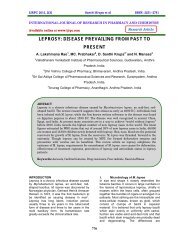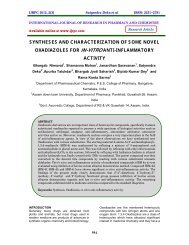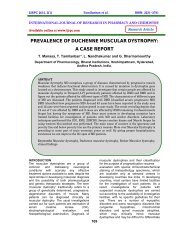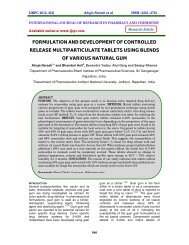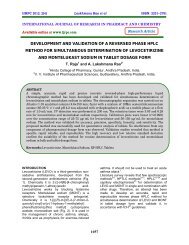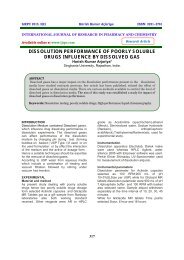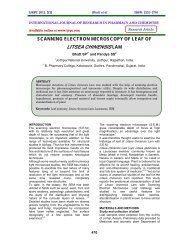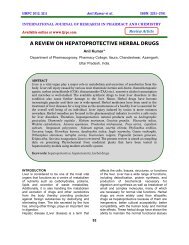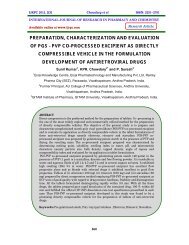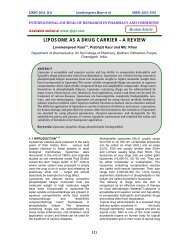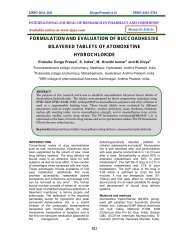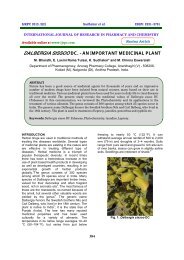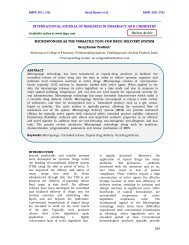Miscibility Studies of Agar-Agar/Starch blends using Various ... - ijrpc
Miscibility Studies of Agar-Agar/Starch blends using Various ... - ijrpc
Miscibility Studies of Agar-Agar/Starch blends using Various ... - ijrpc
Create successful ePaper yourself
Turn your PDF publications into a flip-book with our unique Google optimized e-Paper software.
IJRPC 2012, 2(4) Jagadish et al ISSN: 22312781<br />
As a part <strong>of</strong> our research program, we have<br />
studied miscibility <strong>of</strong> agar-agar/starch <strong>blends</strong> in<br />
solution and solid state. The purpose <strong>of</strong> this<br />
study is to characterize the miscibility nature <strong>of</strong><br />
the agar-agar and starch <strong>blends</strong>. These homopolymers<br />
are extensively used in food and<br />
pharmaceutical industries. Hence blending <strong>of</strong><br />
these polymers might be enhancing their<br />
properties.<br />
MATERIALS AND METHODS<br />
Polymers used for the present study are agaragar<br />
[Merk, Mumbai, India] and starch [Merk,<br />
Mumbai, India] which are natural products.<br />
Viscometric method is based on the study <strong>of</strong><br />
interaction in dilute solutions <strong>of</strong> two polymers<br />
in common solvent. The total weight <strong>of</strong> the two<br />
components in solution is always maintained<br />
at 0.2g/dL. Stock solutions <strong>of</strong> homo-polymers<br />
agar-agar, starch and their <strong>blends</strong> <strong>of</strong> different<br />
compositions (90/10, 80/20, 70/30, 60/40<br />
50/50, 40/60 30/70, 20/80 and 10/90) were<br />
prepared in distilled water. The relative<br />
viscosities <strong>of</strong> the polymer <strong>blends</strong> are<br />
determined at 30ºC and 50ºC <strong>using</strong><br />
Ubbelohde suspended-level viscometer<br />
(USLV). Different temperatures were<br />
maintained in a thermostat bath with a thermal<br />
stability <strong>of</strong> ± 0.05ºC.<br />
Ultrasonic velocity measurements <strong>of</strong> blend<br />
solution <strong>of</strong> different compositions were<br />
performed by an ultrasonic interferometer<br />
technique 6 . During the experiment, different<br />
temperature (30ºC and 50º C) is maintained by<br />
circulating water from thermostat with a<br />
thermal stability <strong>of</strong> ± 0.05ºC, through the<br />
double walled jacket <strong>of</strong> the ultrasonic<br />
experimental cell. The experimental frequency<br />
was 2MHz.<br />
Differential scanning calorimeter (DSC)<br />
technique is used to detect glass transition<br />
temperature <strong>of</strong> polymer <strong>blends</strong>. The thin films<br />
<strong>of</strong> agar-agar, starch and their <strong>blends</strong> were<br />
prepared by solution casting method. Films<br />
were dried <strong>using</strong> IR Lamp. DSC<br />
measurements were performed in TA Q200<br />
Differential Scanning Calorimeter, under<br />
nitrogen atmosphere. During DSC<br />
measurements, heating/cooling/heating<br />
method was used. In the first cycle <strong>of</strong><br />
measurements, sample was heated to 90ºC<br />
and equilibrated to remove remaining water<br />
content in the sample. The sample was then<br />
cooled to 20ºC and reheated to 250ºC. The<br />
heating/cooling/heating rate was set at<br />
10ºC/min.<br />
RESULTS AND DISCUSSION<br />
Viscometric measurements<br />
From viscometric measurements, reduced<br />
viscosities <strong>of</strong> homo-polymers agar-agar, starch<br />
and their blend compositions (90/10, 80/20,<br />
70/30, 60/40, 50/50, 40/60, 30/70, 20/80 and<br />
10/90) were measured at 30ºC and 50ºC.<br />
Reduced viscosities <strong>of</strong> the pure polymers and<br />
their blend compositions are plotted against<br />
concentration are shown in Figures 1 and 2<br />
respectively.<br />
The Huggin’s plot (Figure 1) <strong>of</strong> agaragar/starch<br />
and their blend compositions at<br />
30ºC is indicating little higher slope values for<br />
80/20, 70/30, 60/40 50/50, 40/60 30/70, 20/80<br />
and 10/90 blend compositions than 90/10<br />
blend <strong>of</strong> agar-agar/starch. This may be<br />
attributed to mutual attraction <strong>of</strong> macro<br />
molecules in solution, which leads to increase<br />
in hydrodynamic volume. 7<br />
At 50ºC Huggin’s plot (Figure 2) <strong>of</strong> agaragar/starch<br />
and their blend compositions<br />
indicating little higher slope value for all the<br />
composition. This is may be due to the effect<br />
<strong>of</strong> temperature on mutual attraction <strong>of</strong> macro<br />
molecule in solution.<br />
To quantify the miscibility <strong>of</strong> polymer <strong>blends</strong>,<br />
Chee 8 suggested the general expression for<br />
interaction parameter when the polymers are<br />
mixed in weight fractions w 1 and w 2 as<br />
where b = w 1 b 11 + w 2 b 22 where b 11 and b 22 are<br />
the slopes <strong>of</strong> the viscosity curves for the<br />
components and b is related to Huggins<br />
coefficient K H as,<br />
where [] is intrinsic viscosity<br />
For ternary system, it is also given by<br />
where b 12 is slope for the blend solution.<br />
However, Chee’s theory fails to account for the<br />
experimental data when intrinsic viscosities <strong>of</strong><br />
pure components are far apart. In such cases<br />
he defined a more efficient parameter to<br />
predict compatibility,<br />
where [] 1 and [] 2 are intrinsic viscosities <strong>of</strong><br />
pure component solutions. The polymer blend<br />
is miscible if 0 and immiscible when < 0.<br />
1050



